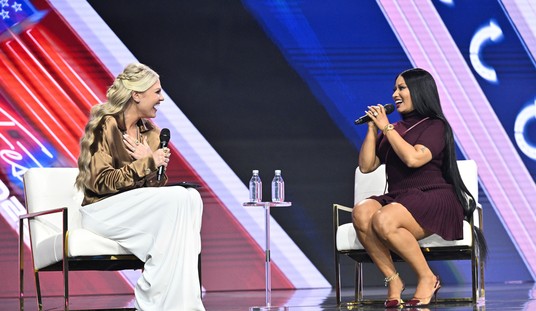That’s the $64,000 question, is it not? While Donald Trump continues to complain about the RNC “rigging” the primary election that he leads, his new team of campaign executives met with GOP’s executive committee in part to woo them — and in part to soothe them. Paul Manafort and Rick Wiley came to the RNC’s spring meeting to explain that they can expand the political map, reported Politico’s Alex Isenstadt, but also to tell them that Trump wants to work with them as the nominee:
Donald Trump’s top brass addressed a skeptical audience of Republican National Committee members here Thursday evening, presenting a detailed case for why he’d be able to defeat Hillary Clinton in a general election.
During a more than one-hour meeting on the third floor of the Diplomat, a luxury resort overlooking the South Florida oceanfront where RNC members are gathered for their annual spring meeting, Trump strategists Paul Manafort and Rick Wiley argued that the New York businessman would expand the number of states in which Republicans would be competitive during the fall campaign. They also said that Trump would be able to add to the states the GOP carried in 2012. …
The presentation was also geared toward convincing RNC members that Trump, who has spurned the traditional relationship-building within the party that most candidates partake in, is serious about building a substantial political apparatus and professionalizing his operation. Accompanying Manafort and Wiley were several other political veterans who’ve recently signed onto the Trump team, including Ed Brookover and Don McGahn. They told the group that they would soon be rolling out additional hires.
Why didn’t Trump himself come to the meeting? One RNC member who spoke to Isenstadt wondered the same thing. Perhaps Trump wants to keep his options open in making the RNC his object of demonization, but sending the top campaign advisers to make nice could complicate that significantly anyway. Plus, the RNC’s executive committee are in fact superdelegates — 168 of them, in fact, which could make the difference in Cleveland. That’s more than the combined bound delegates up for grabs on Tuesday’s Northeastern primaries. A quick appearance in south Florida could have come a long way towards picking off at least a few of them.
Others were more impressed with the presentation, but still not convinced. Manafort and Wiley did promise that Trump would use the RNC’s apparatuses if nominated, and that is no small point. The RNC under Reince Priebus has built a large and well-tested network for a committed ground game, as I write in my book Going Red, in order to push the next presidential contender into a granular, peer-to-peer campaign rather than the top-down, one-size-fits-all messaging and campaign used by Mitt Romney (and John McCain). Trump has shown little interest in that kind of granular operation, and that has to have the RNC worried about what will come after the convention if Trump gets the nod. The assurances from Manafort and Wiley seem aimed at that issue specifically.
In a related issue, Trump has claimed that he will expand the political map against Hillary Clinton.The only test we have at the moment for this clain is head-to-head polling, which isn’t terribly predictive at this point but certainly provides some indication of whether there’s a groundswell of Trump support outside of the traditional Electoral College map. While it’s certainly possible that things could change after the nomination, the best that can be said otherwise of this claim is that there is no evidence at this point of any such movement. Trump explicitly claims he will make New York competitive against Hillary, but we have plenty of head-to-head polling this month, and his RCP average there puts him at 34.5% and Hillary at 55%, just below Romney’s eventual 36% in 2012. In Pennsylvania, Romney got 47%; Trump’s RCP average is 38.8%, and he hasn’t scored above 44% in any poll over the last seven weeks. Romney scored 45% in Michigan, and Trump only got to 40% in one head-to-head poll against Hillary in the state — and that was in September. Romney got 46% in Wisconsin; Trump’s at 36%. And in the must-win state for Republicans — Ohio — Trump hasn’t scored above 44% in a state Romney lost while getting 48% of the vote.
Clearly, Trump’s wins in primaries do not necessarily show evidence that his footprint will improve over that of Romney organically. Unless Trump plans to throw tons of resources into a turnout-model-changing ground game — the kind Priebus envisions with his network — it won’t change any other way, either. That makes the traditional swing states even more important, where the demographics tilt away from the white working-class vote that Trump is energizing. Victories in those states rely on expanding the Republican/conservative footprint in constituencies where a heavy reliance on national messaging and one-size-fits-all slogans have proven fatal to GOP hopes.
Small wonder that RNC members were not convinced. But the other question to ask is this: can Ted Cruz do any better? He’s much better organizationally, which is why Team Trump had to pitch the RNC in the first place. But the head-to-head polling in these states and the key swing states shows only a marginal improvement over Trump’s numbers, at least at this point. His organizational strength would have to prove able of turning out new voters, in places where it matters. The jury’s still out on that question, too.








Join the conversation as a VIP Member